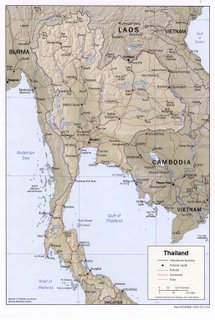
Figured i couldn't start my trip in Thailand without knowing a little about the country's history, culture and religion, so for those of you also interested, firstly here are a few statistics ...
Population : 63.4 million
Area : 513,115 sq km (approximately the size of France)
Cities : Bangkok, Chiang Mai and Nakhon Ratchasima
Language : Thai
Time difference : GMT+7hrs
Currency : Thai Baht
Economy : 60% of Thailand's labour force is employed in agriculture. Thailand is a major exporter in the world's rice market
Ethnic groups : Thai 89% Other 11%
Religion : 95% Buddhism 4% Muslim 1% Christian, Hindu, Brahmin and other
(Data : October 2005, Bureau of East Asian and Pacific Affairs)
How Thailand came into existence, and important historical sites within the country
In 1238 Thai chieftains overthrew their Khmer overlords at Sukhothai. So, under the reign of King Ramkhamhaeng, Sukhothai rose to preeminence and the basis of the Thai nation was established.
Ayuthaya period 1350-1767 A.D
The Burmese reign was short-lived, as under the leadership of General Phya Taskin, the Thai's drove out the Burmese and re-established their capital at Thonburi
Rattanakosin period 1782-present
Theravada Buddhism and its origins
Buddha was born in 563 B.C as Prince Siddhattha Gautama, the son of an Indian king. Siddhattha's father, fearful that he would lead the life of an ascetic, rather than a king, endeavoured to protect his son from the painful realities of life. He kept Siddhattha confined to the grounds of his grand estate, complete with all the pomp and luxury and material comforts that Siddhattha would need to become a great ruler, and far away from pain, suffering, tragedy and death. On 3 ocassions however, Siddhattha managed to leave the confines of the estate and witnessed several scenes that changed the meaning of his existence :
The four noble signs:
- The sight of an old and decrepit man. This made him think about the decay inherent in all life.
- The sight of a sick and ailing man. This made him think about the suffering inherent in existence.
- The sight of corpse lying in a bier. This made him think about the transience of human life and need for liberation from the very experience of death.
- The sight of a meditating monk, who had renounced the worldly life and was leading the life of a monk. It reminded him of the possibilities of spiritual life lying beyond the boundaries of his own materialistic life.
It was at the age of 29 that he renounced his wealth and embarked upon a journey in search of truth and enlightenment .
After studying under many religious teachers and ascetics and never finding the answers he needed, he decided to take some time alone to meditate intensely, concentrating on the nature of life, the nature of reality, the nature of self, and especially the nature of suffering; its cause and its elimination. It is not known exactly how many days he meditated for but he eventually achieved enlightenment underneath a Bondhi tree in the town of Bodhgaya.
He discovered what is known as "the middle path" : the Four Noble Truths concerning the origin of suffering, the cause of suffering , the ending of suffering and the Eightfold path that would lead to the ending of suffering. The middle path was a compromise between material indulgence and extreme ascetisism, and this would form the basis of Buddhist beliefs.
The Four Noble Truths :
- The existence of suffering. Birth, sickness, old age, death, sorrow, dejection and despair are all forms of suffering.
- The cause of suffering is craving or desire. Cravings for pleasures, wealth and power create eventual suffering because of inherent greed and lust.
- Anyone can eliminate the desire (and therefore, the suffering) on his own without the need of Gods to direct our beings.
- The path leading to the end of all suffering (known as the Eightfold Path) It consists of Right view, Right intention, Right speech, Right action, Right livelihood, Right effort, Right mindfulness, and right concentration.
(Four Noble Truths taken from www.asiatours.net)
Buddha taught that all things in the material world are illusory, including the self, and that the secular world is one of impermanence and, ultimately, disappointment. Buddha created a theology based on moderation and the necessity of separation between physical and spiritual existance. "Buddha" simply means "The Enlightened One" and Buddhism is a practice of finding peace within oneself.
No comments:
Post a Comment